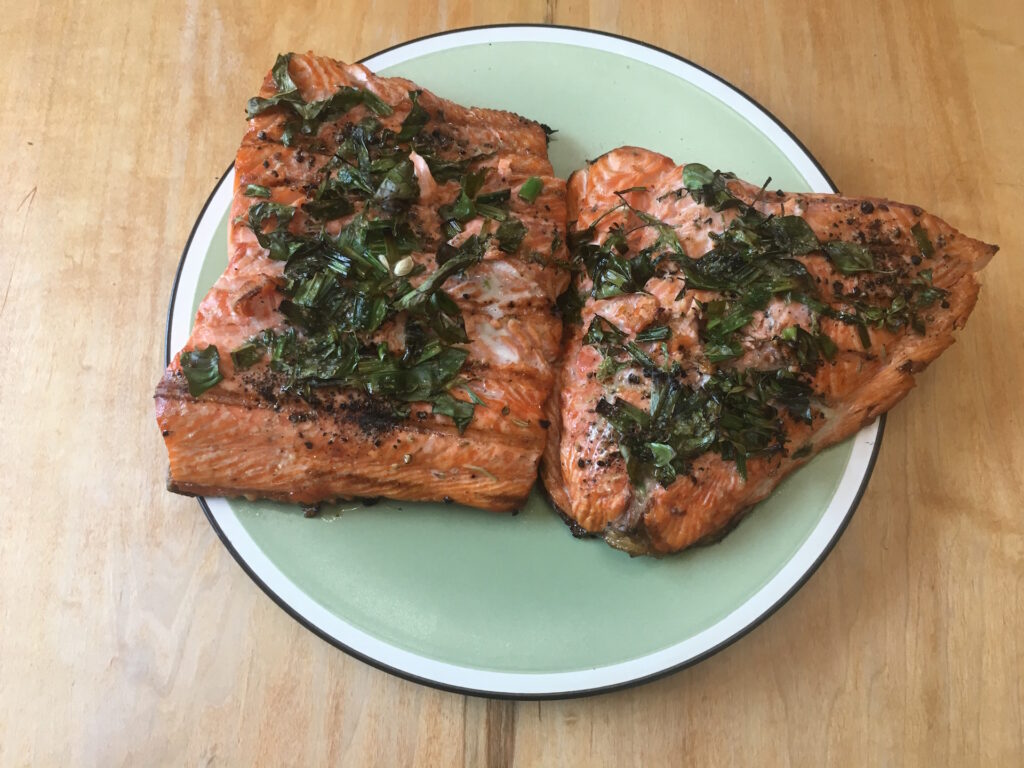At its core, Thanksgiving was and should remain a celebration and appreciation of the bounty of the land and those who are indigenous to the land. To me, the Thanksgiving meal is about celebrating what comes from the land where I live, not what was eaten in Jamestown, Virginia in the 1600s.

Don’t be afraid to feature salmon instead of turkey in your Thanksgiving feast. This salmon is grilled and topped with fresh herbs, garlic, butter, and lemon.
Do you have copious amounts of moose, caribou, salmon, blueberries, or cranberries in your freezer? Or carrots, potatoes, or winter squash stored from the garden? Why not showcase what you gathered, hunted, fished, or grew this year? Why not place an Alaskan meat or fish in the center of the table? Perhaps, prepared in an extra special way for the holidays? Instead of apple or pumpkin pie, why not serve spiced blueberry pie (I add 1/4 cup lemon, 1 teaspoon cinnamon, 1/4 teaspoon nutmeg, and 1/2 teaspoon of cardamom to my blueberry pie filling), cranberry pie with pecan crumble, or cranberry blueberry pie (use half cranberries and half blueberries)? Note: when I say cranberry in this article, I’m talking about Alaska low bush cranberries or lingonberries. Instead of standard dinner rolls, give a nod to the early miners of Alaska or sourdoughs and make sourdough rolls? Cooperative Extension has tons of recipes featuring Alaskan harvested, hunted, gathered or fished ingredients, as well as on how to cook with sourdough. Don’t worry, there aren’t any Thanksgiving police that will come to make sure you have a turkey, stuffing, and pumpkin pie at your celebration (okay maybe you do have one in your family).

I substituted blueberries for blackberries in this blackberry cheesecake galette recipe (left).
This berry cheesecake (right) is covered in a variety of Alaska grown berries including raspberries, black currants, and honeyberries. They are fresh, but I’m sure defrosted berries, perhaps made into a sauce would work equally as well.
If you want to stick with a traditional Thanksgiving spread, consider ferreting out local ingredients for your feast. Certainly, buying local is not as quick or cheap as buying as one-stop-shopping. But if you have the time and can afford it, there might be other reasons to go the local route. In a story called, A New Coat for Anna by Harriet Ziefert, because it was necessary after World War II, Anna and her mom coordinate with a farmer, weaver, and tailor to make a much-needed coat for Anna. Through the process, they make new friends (including with the sheep), and Anna learns what goes into making a coat. I loved this story as a child, and enjoy reading it with my kids now. It speaks to the joy of the journey. Yes, she ended up with a beautiful new coat, but she actually ended up with a lot more—memorable, and interesting experiences. In today’s time of extreme convenience and efficiency, it’s entirely optional to take this journey, but it might be worth choosing. You might make a new friend. You might make a memory. You might see something beautiful. Your kids might appreciate the work that goes into growing or raising food. You might eat the best-tasting turkey of your life.
Turkeys, winter squash (including pumpkins), apples, and of course potatoes are all grown or raised in Alaska. Use the Alaska Grown database to find farmers that grow or raise what you’re looking for, shop at stores that carry local ingredients, or look out for special sales or events where farmers will be selling. Finding local ingredients might involve planning ahead, whether it’s pre-ordering a turkey or preserving some of the ingredients to be used later. And of course why not use lowbush cranberries (lingonberries) for cranberry sauce instead of the lifeless kind found in a can? Here’s my favorite cranberry sauce recipe.
Finally, don’t be afraid to use local ingredients in tasty looking recipes that you found on the Internet or in a new cookbook that call for a non-local ingredient. For example, I used blueberries instead of blackberries in this cheesecake galette recipe and it was worthy of any Thanksgiving feast.
Previously published in the Fairbanks Daily Newsminer November 24, 2019.
